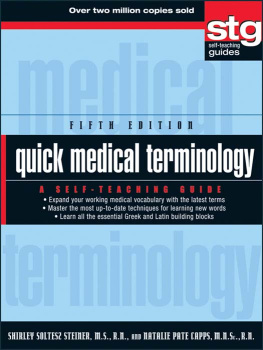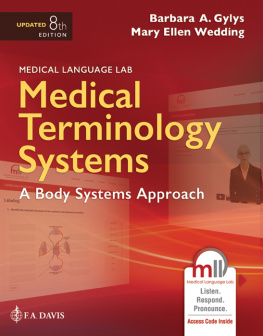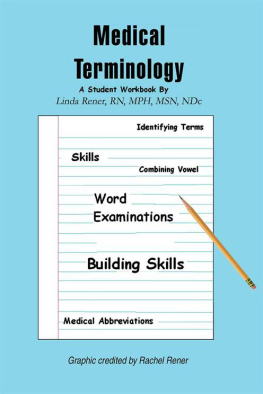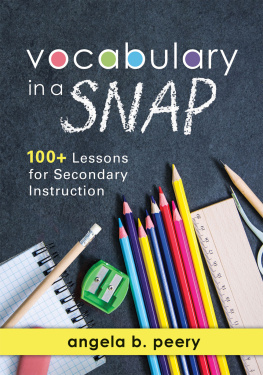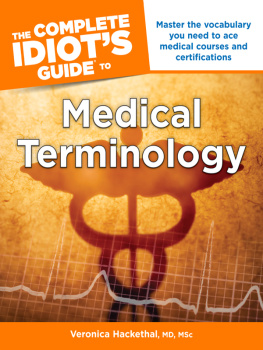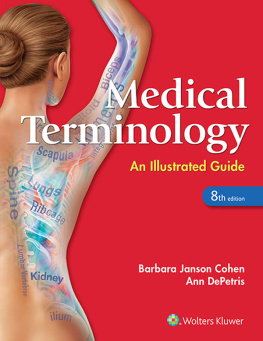Contents
Quick Medical Terminology
Copyright 2003 by Shirley Steiner. Copyright 2011 by Shirley Steiner and Natalie Capps.
All rights reserved
Published by John Wiley & Sons, Inc., Hoboken, New Jersey
Published simultaneously in Canada
No part of this publication may be reproduced, stored in a retrieval system, or transmitted in any form or by any means, electronic, mechanical, photocopying, recording, scanning, or otherwise, except as permitted under Section 107 or 108 of the 1976 United States Copyright Act, without either the prior written permission of the Publisher, or authorization through payment of the appropriate per-copy fee to the Copyright Clearance Center, 222 Rosewood Drive, Danvers, MA 01923, (978) 750-8400, fax (978) 646-8600, or on the web at www.copyright.com . Requests to the Publisher for permission should be addressed to the Permissions Department, John Wiley & Sons, Inc., 111 River Street, Hoboken, NJ 07030, (201) 748-6011, fax (201) 748-6008, or online at http:/www.wiley.com/go/permissions .
Limit of Liability/Disclaimer of Warranty: While the publisher and the author have used their best efforts in preparing this book, they make no representations or warranties with respect to the accuracy or completeness of the contents of this book and specifically disclaim any implied warranties of merchantability or fitness for a particular purpose. No warranty may be created or extended by sales representatives or written sales materials. The advice and strategies contained herein may not be suitable for your situation. You should consult with a professional where appropriate. Neither the publisher nor the author shall be liable for any loss of profit or any other commercial damages, including but not limited to special, incidental, consequential, or other damages.
For general information about our other products and services, please contact our Customer Care Department within the United States at (800) 762-2974, outside the United States at (317) 572-3993 or fax (317) 572-4002.
Wiley also publishes its books in a variety of electronic formats and by print-on-demand. Some content that appears in standard print versions of this book may not be available in other formats. For more information about Wiley products, visit our website at www.wiley.com .
ISBN 978-0-470-88619-9 (paper); ISBN 978-1-118-06373-6 (ebk);
ISBN 978-1-118-06374-3 (ebk); ISBN 978-1-118-06375-0 (ebk)
For
Dorothy Elizabeth Wilson Soltesz, who is my mom and best friend.
Mildred Hall, who is my godmother and may not know how much she influenced my growing-up years. Mildred assured me I had what it takes to go to college, get an education, and create a better life.
S. S.
For
My perfect mate, Barry, and remarkable children, Harden, Pate, and Jacqueline Capps
My parents and sisters, who shaped me:
Susie Ashworth, Nick Pate, Amy Bean, and Molly Pate
With affection, gratitude, and adoration for you all.
N. C.
To the Reader
What This Book Is and Who Its For
So you want to learn the language of medicine. Great! Everything you need for learning medical terminology is right in your hands. The language of medicine is precise and technically oriented. It is among the great tools of the mind for better understanding and more accurate communication between all practitioners of the life sciences. Learning this special language is your opportunity to be among them. Quick Medical Terminology can prepare you for a new job or even a new career in one of the nations fastest growing job markets, health care and allied health services.
In Quick Medical Terminology youll learn to pronounce, spell, and define medical terms used in todays health care settings. You will use a word-building strategy that helps you discover connections and relationships among word roots, prefixes, and suffixes. Youll learn the meaning of each part of a complex medical term and be able to put the parts together and define the term. Very quickly youll develop a large repertoire of useful medical terms, much greater than the 500-plus terms presented in this text.
Beginning with Chapter 4, most of the medical terms in each chapter will focus on a particular part of the body. Grouping related terms in this way will hel you learn them better. However, the order of the chapters should not be confused with the order of a standard head-to-toe medical evaluation. At the end of the book, there is a Review by Body System Assessment that will walk you through the standard head-to-toe examination medical professionals typically follow. This review will bring together the medical terminology you will learn in the rest of the book.
Quick Medical Terminology is an enjoyable way to learn the very special language of medicine by yourself, at your own pace. If you speak and understand English and have a high school education or equivalent, youll quickly learn the basics and much more.
How to Use This Program
We suggest you use the following steps to approach your learning.
Step 1. Pre- and Post-Testing
If its worth learning, isnt it worth knowing you have succeeded? You will find two Final Self-Tests in the back of your guide. We suggest you take one test before you begin your study and take another after you have completed all your lessons. Pre- and post-testing shows you how much you have learned. Either one of the final tests may be used first.
Step 2. Self-Instructional Chapter
This self-teaching guide lets you proceed at a pace that is right for you. It provides everything you need to complete each of the eleven instructional chapters, which include:
Introduction and Mini-Glossary. The first page of each chapter introduces you to what you will cover and provides a Mini-Glossary of the terms and word parts youll be learning. You may want to refer to it as you proceed through the lesson.
Numbered frames. Numbered frames are the building blocks of each chapter. A frame presents a small amount of information and expects you to read and think about that information. Then it asks you to respond to it.
The way you respond may be:
- to select a medical term or definition from a list of suggested answers.
- to write a medical term for a given definition.
- to draw a conclusion and write it in your own words.
Example
Emesis is a term that means vomiting. A term that means excessive vomiting is hyperemesis. Underline the part of the medical term meaning excessive.
A gallbladder attack can cause excessive vomiting. Write the term that describes this unpleasant condition.______________________
Example
Myelo / dysplasia means defective development of the spinal cord.
Chondro means cartilage. What does chondro / dysplasia mean?___________
Answers. As you work through the chapter, youll find the correct answers on the left-hand side of the page. Its a good idea to use a folded piece of paper to cover the answer until you give your own. Your answer will be correct most of the time, but when your answer doesnt match ours, be sure you know why it doesnt. You may need to go back and review a few frames before continuing.
Pronunciation Guide. When you work with a medical term for the first time, the answer column guides your pronunciation of the new term. Take the opportunity to practice pronouncing each new term correctly several times. Say it aloud or subverbally (saying it to yourself).

